CushCore Pro Tire Inserts
Size Tested: 29”
Blister’s Measured Weight (one insert): 267 g
MSRP: $149 (includes 2 inserts + valves)
Mounted to: Trek Slash w/ Race Face Next R Wheels and Enve M7 Wheels
Tires used:
- Maxxis Minion DHF 2.5” Exo Casing
- Maxxis DHF 2.5” DH Casing
- Maxxis DHR II 2.3” Doubledown Casing
- Maxxis DHR II 2.3” Exo Casing
- WTB Vigilante 2.6” Light Casing
- WTB Trail Boss 2.6” Tough Casing
Reviewer: 5’9”, 155 lbs
Location: Whitefish, MT
Duration of Test: ~5 months
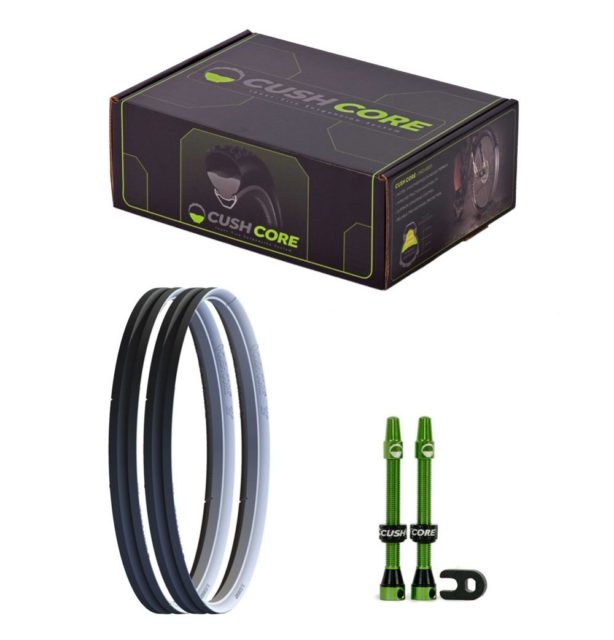
Intro
Tire inserts are one of those products that went from nonexistent to everywhere in a pretty short period of time. A few years ago, the only talk of inserts was from garage tinkerers and whispered speculations about things that were in Aaron Gwin’s tires.
Fast forward to today and there are a ton of inserts on the market with quite a few people raving about the benefits. Throughout the rise of the tire insert, CushCore has pretty much been the leader of the pack, and is arguably still the most well-known insert on the market today. So for those who are curious as to what all the talk is about, here’s my take on the pros and cons of a CushCore setup.
Design & Options
For those unfamiliar, the CushCore concept is pretty simple. It’s a wedge-shaped piece of foam that sits against your rim, inside the tire. The tire is set up tubeless, more or less like normal, but the foam acts as a bumper between the tire and the rim. And that foam bumper effectively changes quite a few aspects of how the wheel and tire react to bumps — most notably, it’s a whole lot harder to get a pinch flat. But we’ll get into that more below.
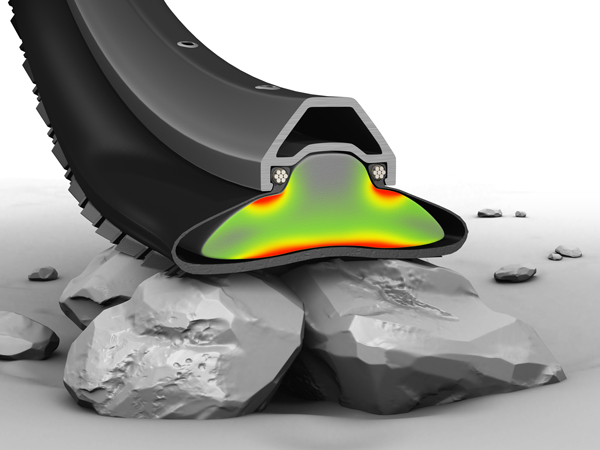
CushCore offers a few versions of their product these days, with a lighter-weight version for XC or light Trail riding, and versions aimed at Plus and gravel bikes. I spent time on the original version (now called CushCore Pro) in the 29” format, mounted on a couple of different rims (Race Face Next R & Enve M730), both of which were ~30 mm wide.
On my scale, the inserts weighed 267 grams each (they both weighed exactly the same, which is at least one indication that CushCore’s quality control is on point). That’s 7 grams more than the advertised weight, which isn’t enough to matter in my mind.
Installation
Roughly half the people I talk to about CushCore have some horror story to tell about how difficult installation is. The other half give a shrug and say it’s really not that bad. I’m in the latter camp — it’s not a big deal. I’d say installing a tire with CushCore is maybe 25% more difficult than a normal tubeless installation.
I’ve installed a few thousand tires in my lifetime, so I went at my first round of installation without bothering to look at CushCore’s installation instructions. I got it on there, but it was a bit of a struggle. Then I watched the installation video on their website, and while the techniques in the video aren’t groundbreaking, they are actually helpful. By the 4th or 5th time I installed a tire with CushCore, the whole process went pretty quickly. So yeah, watch their installation video, and using some long, stout tire levers will make your life easier.
Riding Impressions
There are a bunch of positive attributes that CushCore advertises, so to keep this a bit more organized, I’ll just talk about the ride as it relates to each of those selling points.
Flat Protection
This is the most obvious selling point of the system — the foam acts as a buffer between the tire and the rim, so on a hard impact, it’s much more difficult to pinch the tire between the rim and that pointy thing you just decided to smash into on the trail. At least for me, that’s the #1 cause of flat tires, so it’s nice to not have to worry about flats as much.
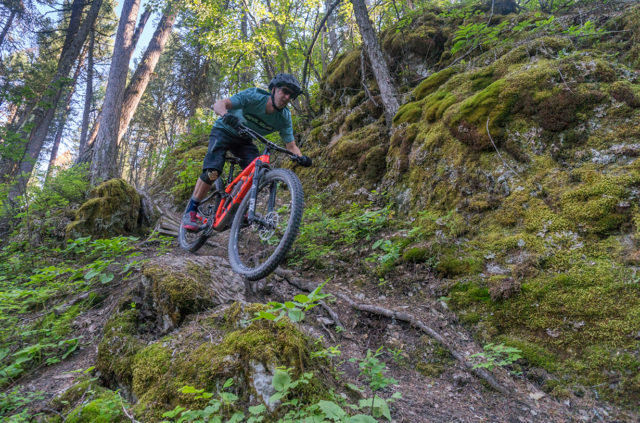
And the ancillary benefit here is that, at least in terms of flat protection, I can get away with a much lighter tire. Most of my time on the Cuschore setup was with a 2.3” Maxxis DHRII rear tire with an Exo casing. Normally, an Exo-casing rear tire doesn’t work for me on any kind of rocky trail; I get too many flats. I generally need somewhere in the neighborhood of 35-40 psi in my rear tire to keep an Exo casing from flatting, and even then, flats still happen more often than I’d like. Ultimately, I just end up running a DoubleDown or DH casing, which takes care of most of my flatting issues and allows me to run much lower pressures (somewhere in the mid-20’s, depending on the trail).
But CushCore changes all of that — with the CushCore setup, I can run an Exo casing rear tire at less than 30 psi and not get any flats. And that’s noteworthy because it more or less cancels out the weight of the foam insert. My CushCore inserts weigh 267 grams each. A 2.3”, 29″ DHRII with an Exo casing weighs around 825 grams, while the same tire with a DoubleDown casing weighs around 1,040 grams. So (rounding a bit), the weight of the CushCore is mostly canceled out by virtue of running a lighter weight tire.
Now, CushCore doesn’t do much (if anything) for other types of flats — it’s not going to help with thorns or other poky things that might puncture your tire, and it’s not going to do too much to prevent you from slicing your sidewall. That’s where a tire with a heavier casing clearly has the durability edge. But as I said above, it’s pinch flats that are the most common form of flatting (for most people), and CushCore does a really good job of preventing them.
Tire Pressure
CushCore says that most riders will end up running around 5 psi less than they would without the CushCore installed. Personally, I found that the question of tire pressure with CushCore was a bit more complicated than a simple “reduce your normal pressure by X” type formula.
It’s true that, in terms of pinch flats, I can get away with running a good bit less tire pressure. But there are other factors at play, namely tire roll — if I go too low with my tire pressure, the tires feel too squirmy in corners. This, of course, is also a problem without CushCore in the tires, and Cuschore does offer some sidewall support. But I don’t find the support offered by CushCore to be nearly as substantial or noticeable as the support you get from the burlier, stiffer sidewalls found in more robust tires (again, using Maxxis as an example, that’d be the Doubledown or DH casings).
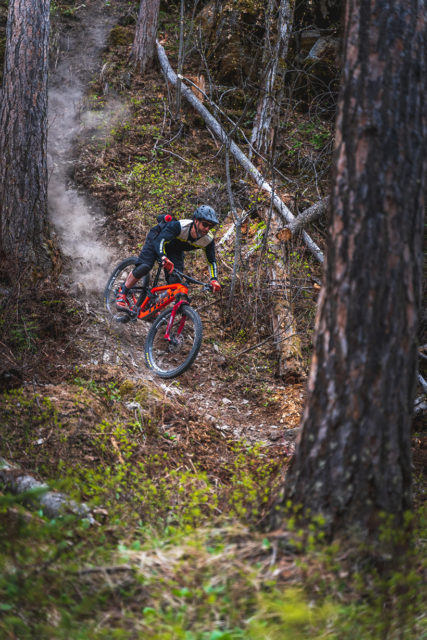
In other words, with CushCore I could get away with an Exo casing as far as flats were concerned, but I still found that I had to run relatively high pressures to keep the tire from getting squirmy in corners. With the Exo-casing DHRII installed, I found the sweet spot (for me) to be around 28 psi. That is quite a bit lower than what I need to run in an Exo tire without Cuschore, but it’s still higher than what I’d normally run in that tire with a Doubledown casing without CushCore.
I also found that the sweet spot for tire pressures with CushCore is a very narrow window, at least with lighter-weight casings. One of CushCore’s talking points is that it reduces the air volume in the tire (since a good portion of the tire’s volume is taken up by the foam), and thus absorbs bumps better. My take is that, while it clearly absorbs bumps differently, I’m not sure it’s always better. And at least for me personally, whether I liked it or not depended a lot on the tire (and casing) I was running.
What that reduced air volume means is that, when you hit a bump, the tire “ramps up” much more quickly. Initially, running my normal tire pressures, I found this to make the bike feel pretty “pingy” on smaller, choppier bumps. By “pingy” I mean that the tire was more inclined to bounce off of small obstacles rather than absorb them. Which makes sense — the tire isn’t compressing as far into its “travel” when it hits a bump (due to the reduced air volume). And, of course, this also means that the tire handles bigger hits more gracefully — it doesn’t bottom out on the rim. But on smaller bumps, there’s a penalty.
Reducing air pressure helped calm down that pingy feeling quite a bit — when set up perfectly, the CushCores give a fantastic, damp feel. But achieving that perfect, damp feel required a pressure that was low enough so that the tire doesn’t bounce off of small bumps. The problem I ran into was that if I reduced pressure too much, I ran into the aforementioned issues with the tires squirming in corners. Ultimately, I found the sweet spot between tire-roll at lower pressures and pingy-ness at higher pressures to be really small in the Exo casing 2.3” DHR II — about 28 psi, plus or minus ½ a psi. And I’ll say, it’s kind of annoying to have such a narrow operating window.
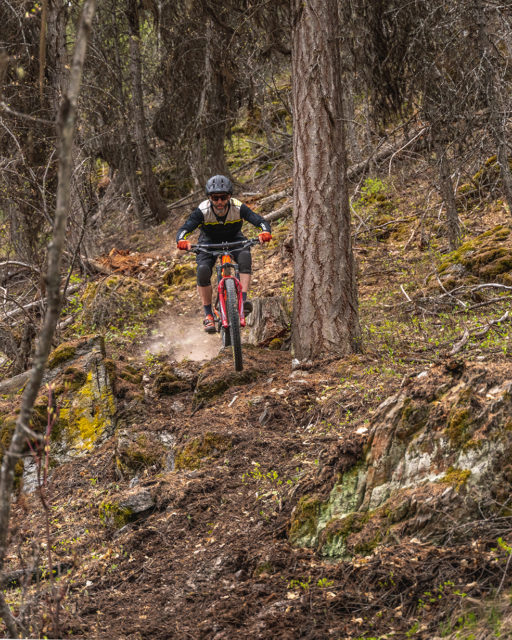
Now, a lot of what I just said goes out the window with burlier tires, and it’s also much less severe with wider, higher-volume tires. The higher-volume thing is logical; a bigger tire has more air in it, so the volume taken up by the CushCore has a bit less of an impact in terms of reducing the air volume. Running CushCores in some 2.6” tires meant that I didn’t need to be nearly as dialed with my air pressure in order to get that damp, smooth ride.
And for burlier tires I find that I can get away with significantly lower pressures with tires that have heavier casings because (among other reasons), they don’t squirm around in corners as much. Adding CushCore to that tire provides a bit more support, so it means that I can run even slightly lower pressures (maybe 1-2 psi lower than I normally would), which, again, produces that nice, controlled, damp ride quality. The downside here, of course, is that I don’t get the weight benefits of running a lighter casing.
There are a lot of details in what I just wrote that are a bit messy to keep straight, so here’s a chart to simplify things. These are for my preferences, and are the pressures I usually run on my local trails. I’m also only talking about rear tires here, but it’s representative of both front and rear. Your results will almost certainly vary, at least in terms of the PSI you need to run.
Tire
Size
Casing
CushCore?
Pressure (psi)
Notes
Exo
No
32+
Exo
Yes
No issues with flatting, but tire gets squirmy in corners below 27 psi. Similar weight to DD w/o CushCore.
No
25-28
My standard setup; pressure gets bumped up for rockier trails. For most places I ride, this is my favorite setup.
Yes
Stiffer casing lets me run lower pressures without squirminess. Setup rides great, but is heavy-ish.
2.4”
DH
No
No
23-27
Yes
22-25
Rides really nicely, but it’s noticeably heavy.
Rolling Resistance
Cuschore has run tests showing that it reduces rolling resistance by around 3%. While I don’t doubt their tests, I’m fairly certain that I can’t notice a 3% difference in rolling resistance by “feel.” Which isn’t to say that 3% is insignificant — that’s actually a fair amount that could stand to make a tangible difference. But I don’t really have anything to say about it in terms of my time on the Cuschore setup.
Durability
So far, the CushCore Pro inserts have held up well. The foam takes a beating from pretty much every notable impact, but so far, it’s taking that beating in stride. There are some marks on the foam where it’s been pinched, but after a couple months of use, they still have plenty of life left.
This is one of the areas where CushCore distinguishes itself from a number of the other foam inserts on the market — higher-quality foam holds up better over time. Yes, it costs more, but at least that price comes with some added durability.
Bottom Line
When it comes to CushCore, there seem to be 3 kinds of people in the world: (1) those who are completely in love with the system and now consider it to be a necessary part of their bike; (2) those who haven’t tried it yet; and (3) me (and one other guy I talked to).
I clearly see the benefit of CushCore — the flat prevention that it offers is undeniable. And on my DH bike where I’m less concerned about weight and more concerned about flat prevention, then yeah, CushCore. For sure. And on my DH bike, I’m running DH-casing tires, so tire-roll issues at lower pressures aren’t as much of a factor unless I’m getting into unreasonably low pressures.
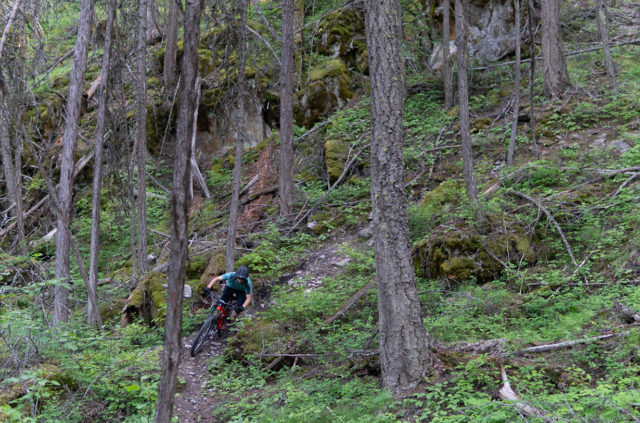
But on my Trail bike, I’m less sold on it. Note that I didn’t say I’m not sold on it — I said that I’m less sold on it. With my normal tire setup (a 2.5” DHF on the front, and a 2.3” DHRII on the back), I’d rather just run a heavier-casing tire. A Doubledown casing (or equivalent from any other tire manufacturer) is usually enough to keep me from flatting, and I prefer the ride of the tire with its full air volume (i.e., without CushCore in there). I also prefer that setup to CushCore installed in an Exo-casing tire — I find I can run slightly lower pressures in a Doubledown tire without CushCore than I can in an Exo tire with Cuschore, and again, I prefer the ride of the tire with its full air volume. Given that the weight between those setups is roughly a wash, I swing towards the Doubledown / no-CushCore option.
But that calculation changes a bit with higher-volume tires, and it also probably changes a bit as I swing more towards a longer-travel Enduro-y bike on severely rocky trails. If I was racing Enduro, or even just riding in an area that was defined by high-speed, rocky descents, then I think the balance would shift back in favor of CushCore. Similarly, if I was a bigger, heavier person that had more of an issue flatting heavier-casing tires, I’d also, without question, turn to CushCore.
So, long story short, I think CushCore makes a lot of sense for a lot of people. I don’t think it’s the answer to every tire-related problem, and I think for some people in some situations (for example, me, in my situation), there are better options. But the benefits are undeniable, and if you’ve already experimented with burlier tires without success, then yes, by all means, CushCore.
2nd Look from David Golay
David Golay: I’ve been riding CushCore on and off on my personal bikes for the last couple of seasons, and while I don’t think what Noah said about it is wrong, I’ve got a bit of a different perspective on what it does (and doesn’t) do well. I’ll be trying to keep this brief, and just highlight where Noah and I see things a bit differently.
Installation
I’ve also heard horror stories about installing CushCores, but in my experience, installation really isn’t that hard once you get the hang of it. The thing I most want to highlight is that you should (1) stretch the insert over the rim before even thinking about the tire and (2) once you get the tire bead seated on the first side, go back around and shove the bead as far under the insert as you can, instead of leaving it seated in the actual bead seat on the rim. Following that procedure, I’ve been able to get tires mounted without even using tire levers.
Flat Protection
Completely agree with Noah here. CushCore does a great job of preventing pinch flats, but won’t help you on other types of flatting. My local trails aren’t very rocky, and here in the PNW we have few poky things to puncture tires, like goat heads. If I’m traveling to somewhere rockier, I’m much more inclined to run Maxxis Double Down or similar casings, but around here, Maxxis Exo casings get the job done for puncture and sidewall protection.
Tire Pressure & Ride
For Trail / Enduro bike use, I’ve settled on mostly running CushCore in the rear, but not the front. For me, the main benefits are (1) pinch-flat protection and (2) sidewall support for cornering, and both of those are bigger problems for me in the rear. On a DH bike, I’d happily run it on both ends and not think about it, but on a Trail bike where weight is more important, using a CushCore only in the rear strikes the best balance of weight and protection for me. The following is focused on that use case (CushCore in the rear, no CushCore in the front).
I’m definitely with Noah that the “standard pressure minus 5 psi” formula that CushCore mentions is not a formula that works for me with CushCore. But in my experience, I do find the sidewall support offered by CushCore in an Exo tire to surpass that of a Double Down tire without CushCore.
If I’m running either a DD or Exo casing without an insert, the minimum pressure I can get away with running is dictated by where I start to feel the casing roll over and fold in corners, and displace the bead enough to “burp” the tire. My ideal pressure is generally a bit higher than that threshold, but that’s the inflection point where the performance really falls off a cliff for me.
The DoubleDown casing definitely offers greater pinch-flat resistance than Exo, but since my limiting factor is folding in corners, and not pinch flats, the DD casing doesn’t allow me to run much lower pressure than I would in an Exo tire (i.e., I still need enough pressure to keep the DD casing from folding in corners). I haven’t recorded pressures obsessively enough to put together a nice chart like Noah did (sorry), but personally, the ideal pressure for an Exo or DoubleDown tire on a Trail bike is basically the same, somewhere around 30-32psi for a 2.4” Maxxis DHR2.
Adding CushCore does two things that I really appreciate: (1) the added support at the sidewall, especially at the bead, has almost entirely stopped me from burping rear tires in corners and (2) has completely stopped me from getting pinch flats. (I definitely just jinxed myself, but I’ve yet to pinch flat a CushCore-equipped tire.)
CushCore does let me drop a couple psi without feeling too squirmy, and also alleviates the harshest-feeling rim strikes I get without it. And I suspect that I haven’t noticed the “pingy” feeling that Noah describes because I generally run slightly higher-volume tires, at somewhat higher pressures, narrowing the difference in ramp-up that he noticed.
While I do think that CushCore offers some very real benefits, with only one significant downside (weight), it’s not such a night-and-day difference that I view it as totally indispensable. Pinch flats and tire burping are relatively infrequent problems for me without CushCore (probably at least in part due to the higher pressures I consistently run), and if I cared more about weight on my bike, I could see a real case for going without (but I am, after all, the doofus with a Fox 40 on the front of his Enduro sled). But for me, the extra weight, in the rear at least, is easily worth avoiding the occasional mid-ride tube installation, and I’ll be running CushCore for the foreseeable future.

It would be interesting if you tried the ‘XC’ version on your trail/enduro bike to compare. It seems that it may strike a better balance of air volume while still giving some support to the sidewalls, and at a lighter weight deficit. One of our ‘enduro’ crew prefers the XCs front/rear.
I’ve heard that these inserts help with the annoying vibrations from riding over small sharp rocks.
True?
I have wrist issues.
my 2cents , highly recommend, new setup is : 2.6 EXO+ Minions with Cushcore front @20 psi and rear @ 22psi on weareone carbon rims. coming from regular exo 2.6s and no CC and rim strike broken wao rim (22/24psi). downside, yep, wheels are a lot heavier now (3/4 ish lbs each wheel). Upsides, many, wheel system feels MUCH more stable and durable. low pressure with huge grip but not squirmy, can really rail pushing corners. dampens rock gardens pin balling and has to put a number on it made my riding 10-15% more aggresive at same comfort level with these changes alone. cant imagine ditching CC any time soon. yes help annoying vibes from sharp rocks/happier wrists stoked in BC PNW
I’m 210 pounds without any gear. I just bought a new Giant Trance 2 and are having them install CushCore. I made the choice to get them because of my weight and the likelihood of pinch-flats. I haven’t come across any good articles on guys that are 200+ pounds. This includes the best suspension size. I think it’s safe for me to assume installing CushCore for a guy my size is money well spent. Not all riders are Noah’s weight.
I installed CushCore after flatting and puncturing the rim tape on a long ride where I had to walk out several miles after (I didn’t have duct tape and the tube just squeezed through the hole were the spoke used to be). One of the biggest benefits for me is knowing that I can get a nasty flat and still ride out without damaging my rims. Also, I’m 225lbs geared up and run mid 20s psi in the back and low 20s in the front with CushCore on exo casing maxxis tires and have not found tire squirm to be a problem at all.
How are you guys getting along with removing a tire that’s got a Cushcore pro fitted?
Could be somewhat sealant dependent I guess because if it dries sticky like Stans and potentially glues the sidewalk to the CC then that seems like a nasty job
I’ve been using MucOff sealant which seems to work as advertised but is wierd stuff that lines the tire with a custard like slime. I’ve not seen it go sticky or garden which might be a Cushcore plus when removal time comes around. Time to put the wet tyres on soon
So far I’ve just been using CC upfront. Geometron G1 / DT 511 29” / Magic Mary 2.3 snakeskin addix soft. CC pro.
I do think it damps nicely and grips better. Rolls well too.